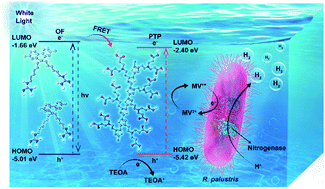Enhancing hydrogen production by photobiocatalysis through Rhodopseudomonas palustris coupled with conjugated polymers†
Abstract
Utilizing solar energy for hydrogen production by combining light-activated materials and biocatalysts has become a promising alternative to fossil fuels. Herein, a feasible and simple bio-hybrid complex based on water-soluble oligofluorene (OF), polythiophene (PTP) and Rhodopseudomonas palustris (R. palustris), one kind of photosynthetic bacteria, was constructed for enhancing photocatalytic hydrogen production. Under the irradiation of visible light, there was fluorescence resonance energy transfer (FRET) between OF and PTP, which amplified photoelectron signals and transferred electrons via PTP to methyl viologen (MV2+), an electron mediator that established electron transfer pathways between organic materials and R. palustris. Hydrogen production involving R. palustris was catalyzed by nitrogenase. It is noteworthy that MV2+ was reduced to MV+˙ and transferred electrons to nitrogenase in R. palustris, converting protons and electrons to molecular hydrogen. Besides, triethanolamine (TEOA) was added as an electron donor to provide electrons to PTP. The proposed OF/PTP/MV2+/TEOA/R. palustris system provided a feasible strategy for photocatalytic hydrogen production with low-cost and easily implemented techniques.

- This article is part of the themed collection: Journal of Materials Chemistry A Emerging Investigators


 Please wait while we load your content...
Please wait while we load your content...